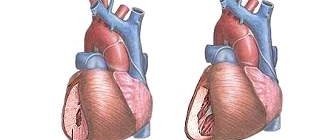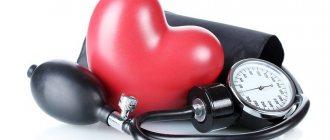Reasons for the formation of pathology
One of the main factors influencing the development of diastolic arterial hypertension is aging and age-related changes in the body, lifestyle and habits of the patient.
An increase in blood pressure is formed due to the following diseases and conditions:
- genetic predisposition;
- cardiovascular pathologies;
- diabetes;
- atherosclerotic vascular changes;
- metabolic failure;
- acute and chronic disorders of renal activity;
- diseases of the endocrinological system;
- oncological processes;
- increased blood viscosity, tendency to thrombosis;
- pregnancy.
The disease often develops in people who eat poorly and are overweight.
Additional risk factors for the development of isolated diastolic hypertension:
- heavy weight;
- improper and excessive nutrition;
- increased salt intake;
- low motor load;
- bad habits;
- excessive physical effort, overexertion;
- emotional overstrain, stress;
- non-compliance with the daily routine, lack of sleep and rest;
- adverse drug reactions.
Return to contents
How is it diagnosed?
Interviewing the patient will help in making a preliminary diagnosis. Systolic-diastolic arterial hypertension can be detected through a general examination of the patient and questioning him about disturbing clinical manifestations. To confirm the diagnosis, blood pressure is monitored throughout the day. It is also important to do an ultrasound diagnosis of the heart and kidneys to exclude possible pathologies of these organs. It is recommended to conduct magnetic resonance and computed tomography of the brain and undergo a general and biochemical blood test.
Degrees of severity and types of pathology
The intensity of the signs of the disease depends on how severe the heart damage is. Isolated diastolic hypertension has the following severity levels:
- In this case, the pressure is below 100 mmHg. Here the symptoms are mild, so the person does not see a doctor. Only malaise and general weakness appear. Painful sensations are present in rare cases, the patient begins to get tired faster.
- The second degree is characterized by an increase in lower pressure to 110 mmHg. The person’s condition noticeably worsens, headaches and shortness of breath appear. Mild antihypertensive drugs can relieve discomfort.
- Third degree of severity. Here the diastolic pressure fluctuates between 110-120 mm. Hg In this case, conservative therapy cannot be avoided.
- The most severe situation is when the pressure level rises to 130 mmHg. and more. If medical assistance was not provided on time, then at this stage irreversible processes begin in the body, increasing the risk of complications and death.
As for the types of the disease, they are as follows:
- Stable systole-diastolic hypertension. It is characterized by a persistent constant increase in pressure. A person will have to take medications for a long time and also lead a healthy lifestyle.
- Labile diastolic hypertension. It occurs in 30% of all cases. Here there is a short-term surge in pressure under the influence of negative factors.
This disease develops over a long period of time. But if you start timely treatment, you will be able to avoid chronicity of the process.
Modern principles of control of mild arterial hypertension
To radically reduce the incidence of complications associated with hypertension (CHD, strokes), it is not enough to pay attention only to patients with moderate and severe forms of hypertension; it is necessary to actively identify and treat people with mild arterial hypertension
Arterial hypertension (AH), the prevalence of which among the adult population is 20%, remains a serious health problem in most countries, including Russia. Hypertension is one of the main risk factors for the development of cardiovascular diseases and mortality from them, the share of which in the structure of overall mortality reaches 50%. To successfully control hypertension and its complications, it is necessary to promptly identify and treat patients with this pathology. This problem is of particular relevance for Russia. According to the latest data from the WHO working group (1997), in recent years in Russia there has been a catastrophic increase in mortality from ischemic heart disease and cerebral strokes, which are the main complication of hypertension. According to these indicators, Russia ranks among the first in Europe.
The problem of controlling hypertension and its complications is complicated by the fact that most patients with this pathology do not complain and do not actively consult a doctor. Increased blood pressure (BP) in this population is found by chance during routine examinations of the population. This category of people is classified as a group of patients with mild arterial hypertension (MAH). The majority of complications associated with hypertension (approximately 60%) occur specifically in the group of people with MAH. Therefore, it is obvious that to radically reduce the incidence of complications of hypertension, it is not enough to pay attention only to patients with moderate and severe forms of hypertension. Individuals with MAH must be actively identified and treated.
- What are the criteria for MAG?
According to the modern classification of hypertension, recommended by WHO and the International Society for the Study of Hypertension in 1993 [1], mild hypertension is diagnosed in cases where diastolic blood pressure is constantly in the range of 90-105 mm Hg. Art. and/or systolic blood pressure - within 140-180 mm Hg. Art. (Table 1).
Table 1. Classification of arterial hypertension by blood pressure level
| Systolic (SBP) and diastolic (DBP) pressure in mmHg. Art. (kPa) | |
| Normal pressure | SBP 140 (18.7) and DBP 90 (12.0) |
| Mild hypertension | SBP 140 - 180 (18.7-24.0) and/or DBP 90 - 105 (12.0-14.0) |
| Borderline hypertension | SBP 140 - 160 (18.7-21.3) and/or DBP 90 - 95 (12.0-12.7) |
| Moderate to severe hypertension | SBP 180 (24.0) and/or DBP 105 (14.0) |
| Isolated systolic hypertension | SBP 140 (18.7) and DBP 90 (12.0) |
| Borderline isolated hypertension | SBP 140 - 160 (18.7-21.3) and DBP 90 (12.0) |
It should be noted that not all countries adhere to these criteria. For example, in the USA, the Joint National Committee on the Detection, Assessment of Severity and Treatment of Hypertension recommended the following MAH criteria: diastolic blood pressure within 90-99 mm Hg. Art. and/or systolic blood pressure in the range of 140-179 mm Hg. Art. [2]. In a number of countries, when studying the effectiveness of antihypertensive drugs in people with MAH, they also used their own criteria for diagnosing this form of hypertension. However, when identifying and treating hypertension, it is still more correct to use the criteria of the WHO and the International Society for the Study of Hypertension.
- What principles should a doctor follow when treating patients with MAG?
First of all, you need to remember the main thing: treatment and preventive measures for people with MAH are a long process aimed not only at reducing blood pressure levels, but mainly at preventing complications. Therefore, the doctor must monitor not only hypertension, but also other risk factors and concomitant diseases that can cause complications. In table Table 2 presents factors that must be taken into account when assessing the overall cardiovascular risk in patients with MAH. All patients with MAH should first of all be given recommendations for the correction of modifiable risk factors.
Table 2. Risk factors for cardiovascular disease
|
To give up smoking. You should strongly recommend quitting smoking in every conversation with the patient. It must be emphasized that people who continue to smoke remain at increased risk of developing coronary artery disease even after their blood pressure has returned to normal.
Weight loss. Of particular importance is excess fat deposition in the abdominal area, which strongly correlates with lipid metabolism disorders and non-insulin-dependent diabetes mellitus. Weight loss not only leads to a decrease in blood pressure, but also has a beneficial effect on the lipid profile and tissue resistance to insulin. American experts recommend a low-calorie diet low in fat and cholesterol (1200 kcal). Based on a cumulative analysis of many studies, it was found that losing 5 extra pounds leads to a decrease in systolic blood pressure by 5.4 mmHg. Art., and diastolic blood pressure - by 2.4 mm Hg. Art.
Increase physical activity. An analysis of many studies shows that regular physical training reduces systolic and diastolic blood pressure by an average of 5-10 mm Hg. Art. Dynamic isotonic exercises, such as walking, are more effective than static exercises such as barbell exercises. Mild exercise, such as brisk walking for 30-60 minutes three to five times a week, is more physiological than intense exercise (running). Physical activity also helps to lose excess weight and improve the functional state of the body. Epidemiological studies indicate that in the group of physically active individuals, not only mortality from cardiovascular diseases, but also overall mortality decreases. Thus, regular physical activity should become an integral part of the prevention of complications in people with MAH.
| Treatment and preventive measures for patients with mild arterial hypertension is a long-term process aimed not only at reducing blood pressure levels, but mainly at preventing complications. Therefore, it is necessary to control both hypertension and other risk factors and concomitant diseases |
Non-drug correction of these risk factors, along with limiting salt intake (no more than 6 g per day) and reducing alcohol consumption should become an axiom for all patients with MAH, regardless of whether they are prescribed antihypertensive drugs or not. Moreover, drug prevention of complications of hypertension can only be successful when it is carried out in combination with non-drug prevention [3, 4]. It has also been shown that non-pharmacological methods - weight loss, increasing potassium intake and limiting sodium intake - can control blood pressure at lower doses of antihypertensive drugs [5, 6]. At the same time, the side effects of the drug were less pronounced, and the quality of life of patients improved when drug treatment was combined with non-drug treatment [7]. In addition, during long-term treatment of persons with MAH, the physician must take into account concomitant diseases that significantly increase the risk of complications, such as diabetes mellitus and renal disease.
Thus, the main question when determining the management tactics for people with MAH is the question of who to prescribe medications to. To answer this, it is necessary to refer to the recommendations of the WHO and the International Society for the Study of Hypertension [8]. If the initial level of systolic blood pressure is in the range of 140-180 mm Hg. Art. and/or diastolic blood pressure - within 90-105 mm Hg. Art., then before a diagnosis of MAH is made and a plan of treatment and preventive measures is determined, it is necessary to re-measure blood pressure at least twice within four weeks (Fig. 1).
| Picture 1 |
This is very important because both systolic and diastolic blood pressure are subject to natural fluctuations. If the patient's systolic blood pressure falls below 140 mmHg over the next four weeks. Art. and/or diastolic blood pressure - below 90 mm Hg. Art., then it is necessary to monitor blood pressure every three months throughout the year. If in the next four weeks systolic and/or diastolic blood pressure remains at the same level, and the overall risk of developing cardiovascular diseases is high, then drug treatment should be started. A high overall risk is determined primarily by the presence of target organ damage: left ventricular hypertrophy, changes in the arteries of the fundus, impaired renal function (plasma creatinine level 1.2-2.0 mg/dl, the presence of protein in the urine). In addition, a high risk is determined by previous history of ischemic heart disease, cerebral stroke, and hereditary history of hypertension. If these diseases and circumstances undoubtedly determine the prescription of antihypertensive drugs, then for factors such as total cholesterol levels, age, smoking, there are quantitative criteria recommended by three European societies (cardiology, the study of atherosclerosis and the study of hypertension) [9]. The authors recommend prescribing antihypertensive drugs to patients whose absolute risk of developing coronary artery disease within 10 years exceeds 20% (Fig. 2). For example, at the age of 40 years, this degree of risk is observed in smokers with a systolic blood pressure level of 180 mm Hg. Art. and a total cholesterol content in the blood plasma of 300 mg/dl, and at the age of 50 years, non-smokers have the same level of cholesterol with a systolic blood pressure of 160 mm Hg. Art. If the risk is low (less than 20%) and there is no organ damage, it is recommended to carry out non-drug treatment and monitor blood pressure over the next three to six months. If after six months the level of systolic blood pressure remains within 140-160 mm Hg. Art. and/or diastolic blood pressure level - within 90-95 mm Hg. Art., then non-pharmacological intervention and blood pressure monitoring should be continued. However, if during the specified period the systolic blood pressure remains at 160 mm Hg. Art. and higher, and diastolic blood pressure - at the level of 95 mm Hg. Art. and above, you need to start
| Success in the prevention of complications of hypertension is determined by combined drug and non-drug treatment of patients with mild arterial hypertension, as well as adequate cooperation between the patient and the doctor |
drug treatment. Thus, the main points that determine the management tactics of people with MAH are: confirmation of the stability of the increase in blood pressure, assessment of the overall cardiovascular risk and decision on the issue of drug treatment.
- What drugs should a doctor give preference if he decides to treat a patient with MAG with medication?
Before answering this question, it is necessary to take into account the experience of long-term studies examining the effectiveness of medications in preventing complications of hypertension. A summary analysis of 17 such studies conducted in different countries around the world in the 1980s suggests that the effectiveness of drug treatment (short-acting beta blockers and diuretics were used in these studies) was evident only in relation to strokes - their incidence decreased by 36% . However, mortality from IHD decreased by only 14% [10]. Since ischemic heart disease is the main complication of hypertension, the overall effectiveness of drug treatment has been considered insufficient. The explanation for this phenomenon comes down to three main reasons. Firstly, the short-acting beta blockers and diuretics used in these studies did not provide a stable reduction in blood pressure throughout the day and especially in the morning and pre-dawn hours, when myocardial infarction, stroke and sudden death most often develop in people with hypertension. Secondly, these drugs, when used for a long time, caused a number of metabolic changes - impaired lipid metabolism, decreased glucose tolerance, decreased tissue sensitivity to insulin, which could neutralize the effect of lowering blood pressure. And finally, drug prevention was not accompanied by non-drug correction of risk factors, the importance of which was discussed above. Thus, at present, preference in long-term treatment of MAG should be given to those drugs or their dosage forms that provide a stable decrease in blood pressure throughout the day and do not cause metabolic disorders. These drugs include, first of all, long-acting forms of calcium antagonists and ACE inhibitors. As a result of our study, the majority of patients with MAH were able to adequately control blood pressure levels using the calcium antagonist isradipine (trade name “Lomir”) and the ACE inhibitor volsartan (trade name “Diovan”). Both drugs are produced by Novartis Pharma (Switzerland). Moreover, these drugs, like most drugs of the calcium antagonist group, do not cause negative metabolic effects. Other long-acting calcium antagonists that deserve attention are isoptin retard form - 240 mg (Knoll, Germany), altiazem (diltiazem retard form, Berlin-Chemie, Germany), amlodipine (trade name “Norvasc”, Pfiser, USA). Among the ACE inhibitors, the drug ramipril (trade name Tritace, Hoehst, Germany) should be noted. This drug not only steadily reduces blood pressure throughout the day, but also causes a reverse development of myocardial hypertrophy even in the smallest doses (1.25 mg), which are insufficient to reduce blood pressure. Also worthy of attention is a new drug from the group of centrally acting sympatholytic drugs - moxonidine (trade name “cynt” - Elli Lilly, USA), which is an agonist of imidazoline receptors located in the ventrolateral part of the rostral brain stem. According to our research, as well as foreign colleagues, this drug not only causes a stable decrease in blood pressure throughout the day, but also increases tissue sensitivity to insulin.
The antihypertensive drugs listed above cover two of the five classes currently used to treat hypertension. To finally resolve the question of how effective they are than other classes of antihypertensive drugs, long-term studies are needed in terms of the effectiveness of reducing complications of hypertension. So far, such studies have only been conducted with beta blockers and diuretics, as discussed above. Moreover, in certain situations when, for example, hypertension is combined with coronary artery disease, arrhythmia, or heart failure, it is impossible to refuse the use of diuretics and beta blockers, since these drugs improve survival in this category of patients with hypertension. In general, when choosing an initial drug for the treatment of hypertension, it is necessary to be guided by both the presence of metabolic disorders and concomitant diseases and complications (Table 3). If, in the treatment of hypertension in a particular patient, any of the five main groups is ineffective, it should be replaced with another drug. If monotherapy is not effective enough, it is better to add small doses of another drug than to increase the dose of the original one. Given the different mechanisms of action of antihypertensive drugs, the chance of suppressing pathophysiological factors that prevent blood pressure from lowering increases. In addition, combination therapy can also reduce side effects due to the use of small doses of drugs.
Table 3. Recommendations for choosing the initial drug for the treatment of arterial hypertension
| Drug class | Indications | Contraindications | Limited |
| Diuretics | Heart failure. Old age of the patient. Systolic hypertension | Gout | Diabetes. Pregnancy*. Increased sexual activity in men |
| Beta blockers | Angina pectoris. Previous myocardial infarction. Tachyarrhythmia. Pregnancy | Bronchial asthma and chronic obstructive pulmonary diseases. Peripheral vascular diseases. Heart blocks** | Hyperglyceridemia. Insulin-dependent diabetes mellitus. Heart failure. Athletically challenging and physically active individuals |
| ACE inhibitors | Heart failure. Left ventricular hypertrophy. Previous myocardial infarction. Diabetes with microalbuminuria | Pregnancy. Bilateral renal artery stenosis | |
| Calcium antagonists | Angina pectoris. Peripheral arterial diseases. Old age of the patient. Systolic hypertension. Low glucose tolerance | Pregnancy | Congestive circulatory failure*** Heart block**** |
| Alpha blockers | Prostate hypertrophy. Low glucose tolerance | Orthostatic hypotension | |
| * – due to a decrease in plasma volume ** – atrioventricular blocks of the second and third degrees *** – either avoid or prescribe with caution **** – either avoid or prescribe verapamil and diltiazem with caution | |||
An integral part of measures for long-term prevention of complications of hypertension should be educational programs for both doctors and patients. After all, if we assume that for each specific patient with MAH the doctor will develop an ideal program of drug and non-drug treatment, it will be very difficult to implement this due to the low motivation of patients for treatment. As a result, for example, in Central Europe, only 22% of patients with hypertension can adequately control blood pressure, and in Russia - only 12%. The most striking example of the effectiveness of educational programs is the program to control hypertension and its complications, conducted in the United States since the 70s. As a result of active educational work, which was part of the project to control hypertension, the awareness of patients about this disease increased significantly, the coverage of their treatment expanded, and the number of adequately treated individuals increased. This led to the fact that over the 20-year period of the program, mortality from cardiovascular diseases was halved. Well-known American scientists in many publications emphasize the role of the educational program in this achievement.
| When choosing an antihypertensive drug for the treatment of mild arterial hypertension, it is necessary to take into account concomitant complications and diseases, as well as metabolic disorders |
The doctor should inform the patient with MAH about the risk of complications, factors and diseases associated with hypertension, and also talk about methods of drug and non-drug treatment of this disease. Each stage of treatment and prevention must be agreed upon with the patient. It is necessary to find out which medications and methods of non-drug prevention the patient prefers. Such measures should ensure the conscious participation of the patient in the treatment and prophylactic process and increase its effectiveness. In conclusion, it must be emphasized that success in preventing complications of hypertension will be determined by active identification and combined drug and non-drug treatment of people with MAH, subject to adequate cooperation between the doctor and the patient. This will require significant efforts on both sides, without which a fundamental change in reducing the complications of hypertension can hardly be achieved.
References
1. Subcommittee of WHO? (ISH Mild Hypertension Liasion Committee. Summary of the World Health Organization-International Society of Hypertension guidelines for the management of mild hypertension // Br. Med. J. 1993; 307: 1541-6. 2. Joint National Committee on Detection, Evaluation and Treatment of High Blood Pressure (JNC V) // Arch. Intern. Med. 1993; 153: 154-83. 3. Britov A., Elisseeva N., Beloussov S., Golub AG Outpatient experience in Treatment of Pts with Mildness Hypertension in Occupational Groups: From Drug Trial to Practice. New York, 1987; 213-18. 4. Kalinina A. M. The influence of long-term multifactorial prevention of coronary heart disease on some health indicators and life prognosis: Abstract of thesis... Dr. med. . nauk. M.: 1993( 45. 5. Chalmers GP The place of combination therapy in the treatment of hypertension in 1993 // Clin. Exper Hypertens 1993; 15(6): 1299-313. 6. Siani A. et al Increasing the dietary potassium intake reduces the need for antihypertensive medication // Ann. Intern. Med., 1991; 115: 753-9. 7. Neaton JD, et al. Treatment of Mild Hypertension Study. Final Results // J. Am. Med. Ass. 1993; 270(6): 713-24. 8. Fight against arterial hypertension. Dokl. WHO Expert Committee // Trans. from English Joint ed. GNITSPM MZ RF and RKNK MZ RF. Moscow, 1997, p. 93-96. 9. The Task Force of the European Society of Cardiology, European Atherosclerosis Society and European Society of Hypertension // Eur. Heart. J. 1994; 15: 1300-1331. 10. MacMahon S., Rodgers A. The effects of antihypertensive treatment on vascular disease: reapprisal of the evidence in 1994 // J. Vasc. Med. Biol., 1993; 4: 265-71.
Conservative treatment
If a diagnosis of “diastolic hypertension” has been established, the causes have been accurately established, and the pathology has a moderate or severe degree of development, then treatment will be carried out in a hospital. If you have problems with your aortic valve, you may need surgery to replace it.
Treatment of diastolic hypertension with drugs is prescribed by a therapist and cardiologist. Funds are selected individually. Drug therapy should be comprehensive and include several groups of drugs:
- Diuretics: “Furosemide”, “Diuver”.
- ACE inhibitors: Captopril, Benazepril. These medications block the action of an enzyme that causes changes in blood pressure.
- Beta blockers: Carvediol. These drugs reduce the heart's need for oxygen. They also dilate blood vessels well, which helps to quickly reduce blood pressure. Other medications of this type reduce the level of glucose in the blood plasma. You will not be able to buy adenoblockers at the pharmacy yourself, since they are sold strictly according to a prescription.
- Calcium channel blockers: Nifedipine, Verapamil. They are allowed to be used only in cases of severe symptoms. They are indicated when urgent relief of a hypertensive crisis is necessary.
- Angiotensin receptor blockers: Losartan.
It is prohibited to use all medications on your own. A doctor's consultation is required. The medications must be taken regularly.
- What is systolo-diastolic arterial hypertension
Complications and treatment of hypertension
Constantly elevated diastolic pressure leads to very serious, life-threatening complications, such as:
- A certain type of stroke called subarachnoid hemorrhage.
- Congestive heart failure.
- Kidney failure.
- Abdominal aortic aneurysm.
There is compelling evidence that high diastolic blood pressure is correlated with dementia.
Studies have shown that successful treatment of high diastolic blood pressure significantly reduces the risk of developing Alzheimer's disease.
The danger of increased lower pressure consists of the following deviations:
- the occurrence of a stroke;
- improper functioning of the heart;
- impaired renal function;
- aneurysm of vessels located in the abdominal cavity;
- infrequently, but the development of dementia (Alzheimer's disease) can still be triggered.
Increased diastolic pressure must be dealt with. For this, the patient will need a full examination and hospitalization. After receiving the results, a diagnosis is made and a treatment method is selected. In some cases, surgery may be recommended. This occurs when pathology of the aortic valve is detected.
- Products that will help remove salts from the body.
- Medicines that reduce heart rate.
- Drugs that can block calcium channels.
- Drugs for the treatment of heart and kidney failure.
The doctor prescribes treatment for each patient individually. Prescriptions cannot be used for a person with a similar problem. With long-term treatment and the right approach, a positive effect can be achieved: tension in the blood vessels will be relieved, and the functioning of diastole (heart muscle) will be restored. Then the heart will work in a normal rhythm and all other organs will not experience a lack of blood and oxygen.
Diagnostics
Arterial hypertension is confirmed by a doctor if, during three patient visits at intervals of a couple of weeks or during independent blood pressure measurements, its level is more than 140/90 mmHg. Art. If there are characteristic symptoms of hypertension, it may not be possible to record an accurate pressure reading, then you need to carry out daily monitoring, paying close attention to the night and morning blood pressure levels. To determine the causes of the disease, confirm or refute secondary isolated systolic hypertension, the following are prescribed:
- study of renal fractions;
- biochemistry, general blood test;
- ECG, ultrasound of coronary arteries, heart;
- lipid profile;
- Ultrasound of the adrenal glands, kidneys;
- analysis of thyroid hormones, etc.
Symptoms
The clinical picture of the disease is characterized by patients feeling a rapid heartbeat.
- fatigue;
- flush of heat to the face;
- dyspnea;
- cardiopalmus;
- arrhythmia;
- weakness;
- severe headache of a pressing or bursting nature;
- dizziness;
- loss of consciousness;
- noise in ears;
- a veil before the eyes;
- drowsiness and inability to sleep;
- irritability;
- cognitive disorders;
- nosebleeds;
- paresis;
- paralysis;
- loss of sensitivity and speech function.
Width and etiology
An average of 40 hundred patients with heart failure may have preserved systolic function.
The incidence of diastolic heart failure increases with age, and is more common in summer women. The most common causes of diastolic cardiac failure are hypertension and myocardial ischemia (Table 1). Some provoking factors include volume overload, tachycardia, physical exercise, hypertension, ischemia, systemic stress (such as anemia, fever, infection, thyrotoxicosis), arrhythmia (such as atrial fibrillation b, atrioventricular nodal block), increased salt intake, as well as stagnation of non-steroidal anti-inflammatory drugs. Table 1. Causes of diastolic dysfunction and heart failure
Wider reasons
Unexpanded reasons
|
Likuvannya
Primary prevention of diastolic dysfunction includes supplementation with chicken and aggressive control of hypertension, hypercholesterolemia, and cholesterol. Similar to effective treatments for chronic diastolic and systolic heart failure are modification of the way of life, as well as low blood pressure, smoking, diet changes, and alcohol consumption. and regular physical exercise. Diastolic dysfunction may be obvious for many years before it becomes clinically obvious. Early diagnosis and treatment are important to help prevent irreversible structural changes and underlying systolic dysfunction. However, the same drug does not have pure lusitropic effects (selective enhancement of myocardial relaxation without inhibiting the speed of the left ventricle). Therefore, drug therapy for diastolic dysfunction and diastolic heart failure is often empirical and not as clearly defined as treatment methods for systolic heart failure. At first glance, you might think that pharmacological treatment of diastolic and systolic heart failure is not significantly affected, but treatment of diastolic heart failure is common every day. 100 great and lasting randomized clinical studies. In addition, optimal management of systolic heart failure may aggravate diastolic heart failure. Most clinical studies to date have focused specifically on patients with systolic heart failure; Only recently, studies have begun to emerge that involve the treatment of diastolic heart failure.
Although there is no residual data on completely specific treatment methods for diastolic heart failure, the joint recommendations of the American College of Cardiology and the American Heart Association state that For treated diastolic heart failure, doctors have focused on controlling arterial pressure, heart rate, and decreased circulating blood volume. and altered myocardial ischemia.
These recommendations are aimed directly at the causes of diastolic dysfunction and, obviously, improve the function of the left shunt and optimize hemodynamics. Table 2 shows the goals of treating diastolic heart failure. Table 2. Treatment goals for diastolic heart failure
ACE - angiotensin-converting enzyme; ARBs are angiotensin receptor blockers. |
Diagnostics
Cardiac failure can manifest itself as second heart failure during physical exercise, paroxysmal heart failure, orthopnea, dilation of the jugular veins, rales in the legs, tachycardia, pathological third or fourth heart sounds, hepatomegaly With it and the marks. Cardiomegaly and venous congestion in the legs are often detected by chest X-ray. However, these findings are nonspecific and are often detected in non-cardiac conditions, such as pulmonary disease, anemia, hypothyroidism and obesity. In addition, based on physical findings, it is important to differentiate between diastolic heart failure and systolic heart failure.
The value of brain natriuretic peptide (BNP) in patients can accurately differentiate cardiac failure from non-cardiac failure in patients with diastolic heart disease, but this test cannot differentiate diastolic heart failure. heart failure as systolic.
Two-dimensional echocardiography with Doppler ultrasound is useful for obtaining fundamental information on the size of the heart chambers, thickness of the walls, segmental speed and total systolic function, valves and pericardium, as well as to assess the characteristics of the diastolic transmitral hemorrhage and pulmonary venous hemorrhage. With peak Doppler sonography, the fluidity of the hemorrhage through the mitral valve at the hour of early diastolic blood pressure is consistent with curve E, while the fluidity of the hemorrhage at the hour of anterior atrial contraction is consistent with curve A. These data are calculated according to the E/A ratio. The norm is that the amplitude of the signal E for the amplitude of the signal A and the correlation E/A becomes approximately 1.5.
In the early stages of diastolic dysfunction, the relaxation process is disrupted and, due to the rate of energy velocity, the E/A ratio decreases and becomes less than 1.0. As the illness progresses, the flexibility of the left ventricle decreases, as a result of which the pressure in the left atrium increases and, in turn, increases the early swelling of the left ventricle, regardless of the disruption of its relaxation tsії. This paradoxical normalization of the E/A relationship is called pseudonormalization. In patients with significant diastolic dysfunction, it is important to improve the left sac in early diastole, as a result of which the E/A ratio becomes above 2.0. Fluid E and A are influenced by circulating blood volume, mitral valve anatomy, mitral valve function, and the presence of atrial fibrillation, which reduce the reliability of Doppler assessment of the transmitter. bloodshed. In such cases, tissue Doppler images are used to visualize the mitral ring (an indicator of transmitral blood flow, which is independent of predictive factors).
Cardiac catheterization is no longer an important method for diagnosing diastolic dysfunction. However, in routine clinical practice, two-dimensional echocardiography with Doppler sonography is the most common non-invasive method for confirming the diagnosis. In minor cases, if echocardiography is technically difficult to perform, radionuclide angiography can be used.









